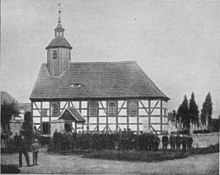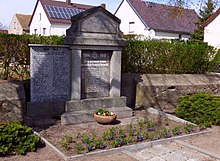Nauwalde village church
The village church Nauwalde is a listed church building in Nauwalde , a district of the small town of Gröditz in the Saxon district of Meißen .
The brick building , built in Art Nouveau style in 1905 according to plans by Leipzig architect Paul Lange, can be found in the center of the village with an adjoining cemetery . There was originally a half-timbered church from the early 18th century on the site . This fell victim to a fire caused by a lightning strike in 1902.
Building description and history
A church in Nauwalde was first mentioned in a document in 1529. This Nauwalde church was originally a branch church of the church in Kröbeln until 1838 . According to the regulations of the Congress of Vienna in 1815, the Kingdom of Saxony , to which Nauwalde and Kröbeln also belonged, had to cede large parts of its national territory. The newly created state border ran along the road between Ortrand and Mühlberg and thus right through the parish . The municipality of Kröbeln was now part of the Merseburg administrative district of the Prussian province of Saxony . Nauwalde remained with Saxony. From 1838 Nauwalde then moved to the parish of Nieska.
Nauwalde is currently part of the Evangelical Lutheran Church Community of Gröditz and Nauwalde , which also includes Nieska , Frauenhain and Spansberg .
Previous construction
A half-timbered church was to be found at the current location of the Nauwalder church until 1902. This structure was erected in 1716. In the west of the nave it had a tower in the form of an octagonal ridge turret with a double hood, lantern and a weather vane that bore the year 1718. There was a small vestibule on the south side. It was equipped, among other things, with a wooden pulpit, a sandstone baptism and an altar from 1520. This altar came from the workshop of the Grossenhainers Pankratius Grueber and was bought in 1904 by the Saxon Antiquities Association and placed in its museum. The center piece of the altar is said to have been preserved to the present day and is located in the Bautzen cathedral . In addition to this altar, works by Pankratius Grueber have also been preserved in Dobra and Tröbitz .
The historic building fell victim to a fire caused by a lightning strike in 1902.
Today's church
The church in Nauwalde was rebuilt. Today's church is a plastered brick building built in 1905 by the Leipzig architect Paul Lange in Art Nouveau style. The church has a choir in the east with a three-sided east end. A sacristy can be found on the south side of the building . The rectangular tower in the west has a square upper floor and a copper-covered dome with a lantern . The interior of the church, like its exterior, is shaped by Art Nouveau. It has a flat roof, the apse is spanned by a ridge vault. A triumphal arch can be found between the hall and choir of the church . Three sides of the church are provided with single-storey galleries . In the windows there are portraits of the two reformers Luther and Melanchthon
The church is equipped, among other things, with an altar, which was once donated by the Burschenheim of the L. Bolle Mission in Berlin Alt-Moabit .
At the end of the 1980s the church was in a very poor structural condition. Concrete and extensive restoration work was only carried out after the fall of the Wall . From the beginning of the 1990s, restoration measures were therefore carried out on and in the church. The renovation of the interior of the structure was completed by 2010 . Two years later, the exterior renovation was also completed.
organ
The organ in the church today dates from 1905. The instrument was created in the workshop of the Olbersdorf organ building company A. Schuster & Sohn (Opus 43), which was owned by Georg Schuster at the time. The organ is located on the west gallery of the building. It has 16 registers on two manuals and a pedal with pneumatic cone chests .
The completely preserved instrument with a simple Art Nouveau case is currently in a very poor structural condition according to the homepage of the church district of Meißen-Großenhain .
The disposition is as follows:
|
|
|
|||||||||||||||||||||||||||||||||||||||||
-
Coupling :
- Normal coupling: II / I, I / P, II / P
- Super octave coupling: I / I
- Sub-octave coupling: II / I
- Playing aids : Fixed combinations (groups) (MF, FF), trigger, crescendo roller , crescendo on, coupling off, hand register on, calcant
Bells
Of the three bronze bells originally acquired with the new church in 1905, none have survived. At that time they were created in the Dresden art and bell foundry C. Albert Bierling . During the First World War, the two smaller bells had to be handed in for war purposes. In 1926 these two bells were re-cast.
After two bells had to be handed in again during the Second World War , this time the two larger ones, only the smaller of the two bells from 1926 has survived.
Dunning and remembrance
Immediately next to the church's cemetery wall there is a monument to the fallen on a two-tiered base in the form of an attached portal with a triangular gable end. The memorial with an inscription commemorates the villagers of the municipality of Nauwalde who died in the First World War .
Immediately to the left of the original memorial is a plaque with the names of the villagers who died in World War II.
Trivia
From the half-timbered church, which burned down in 1902, a weather vane from 1717 has also been preserved.
Literature (selection)
- Cornelius Gurlitt : Official Authority Grossenhain (Land) . Dresden 1914, p. 188-190 .
Web links
- The Ev.-Luth. Parishes of Gröditz and Nauwalde on the homepage of the Evangelical Lutheran parishes of Gröditz, Frauenhain and Nauwalde
- The Nauwalder village church on the homepage of the church district Meißen-Großenhain
Notes and individual references
- ↑ List of monuments of the State of Saxony , accessed on September 22, 2017.
- ↑ a b The Nauwalder village church on the homepage of the church district Meißen-Großenhain , accessed on September 22, 2017.
- ↑ a b c d e f g h i j k l m Bernd Damm: Nauwalde Church . (Tourist information sheet).
- ↑ Publication: Peace treatise between Ihro Königl. Majesty of Saxony etc. and Ihro Königl. Majesty of Prussia etc. completed and signed at Vienna the 18th, and ratified on May 21st, 1815, Dresden [1815]. in the state archive of Saxony-Anhalt
- ↑ a b c d Cornelius Gurlitt: Amtshauptmannschaft Grossenhain (country) . Dresden 1914, p. 188-190 .
- ↑ Nauwalde in the "Historical Directory of Saxony" , accessed on October 1, 2017
- ↑ a b c d e f g h i j k l The Nauwalder Church on the homepage of the Evangelical Lutheran Congregation Gröditz , accessed on October 1, 2017.
- ^ Felix Hoffmann , M. Karl Fitzkow : Works of art of old Großenhainer masters . In: Home calendar for the Bad Liebenwerda district . Bad Liebenwerda 1962, p. 223-226 .
- ↑ a b c Georg Dehio: Handbook of German art monuments - Saxony I . 2nd Edition. 1996, ISBN 978-3-422-03043-5 , pp. 628 .
- ↑ a b Data sheet of the Nauwalder Schusterorgel on the homepage of the church district Meißen-Großenhain, accessed on October 1, 2017.
- ↑ As of 2017
- ↑ a b online project memorials for the fallen , accessed on October 1, 2017
Coordinates: 51 ° 25 ′ 19.6 ″ N , 13 ° 24 ′ 27 ″ E





